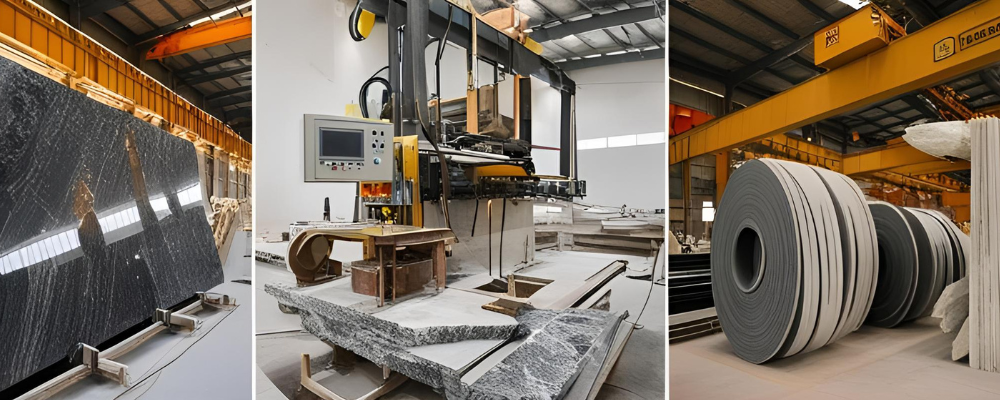Granite Manufacturing Process: From Rocks to Tiles
Introduction
Granite is a well-known igneous rock widely used in construction and interior and exterior decoration. It is valued for its high durability and attractive appearance, making it a preferred choice for many applications. Behind this beautiful final product lies a long series of precise processes, starting from extracting raw rocks to transforming them into polished tiles ready for use. In this article, we will detail each step of granite manufacturing.
1. Quarrying the Rocks
a. Selecting Quarry Sites
Granite extraction begins by selecting suitable quarries containing high-quality rocks. Locations are determined through detailed geological studies analyzing rock composition to ensure market requirements are met. These studies include identifying the type, color, and texture of granite, which greatly influence its final use.
b. Extraction Techniques
Granite is extracted using advanced equipment and techniques such as diamond wire saws and controlled small explosives. Diamond wire saws precisely cut rocks, minimizing waste. Environmentally friendly methods are employed to reduce the environmental impact.
c. Transporting Large Blocks
After extraction, massive blocks are transported to factories using heavy-duty trucks capable of bearing the weight. Blocks are carefully arranged to avoid breakage during transit and are often wrapped with protective materials to preserve quality.
2. Cutting Blocks into Slabs
a. Preparing the Blocks
Upon arrival at the factory, blocks are inspected for cracks or defects. Sometimes the outer layer is removed to improve cutting quality. Large blocks may be cut into smaller pieces for easier handling.
b. Cutting Machines
Large multi-blade saws slice the blocks into slabs of varying thickness. Computer-controlled systems ensure precise cuts. Thickness varies by end-use, with thicker slabs used for exterior projects and thinner ones preferred for interiors.
c. Waste Management
Cutting waste such as dust and rock fragments is collected and repurposed in other industries like concrete production or land filling, supporting sustainability in granite manufacturing.
3. Polishing the Slabs
a. Polishing Stages
Slabs pass through a series of diamond abrasive belts in multiple stages:
-
Roughing: removes surface roughness and levels the slab
-
Smoothing: improves surface smoothness and uniformity
-
Final Polishing: adds a reflective shine that enhances color and natural granite texture
b. Quality Control
After each stage, slabs are inspected for uniformity and defects like cracks or color inconsistencies. Advanced measuring tools check slab thickness and polishing quality.
c. Additional Treatments
Sealants may be applied to increase stain and moisture resistance, making granite suitable for kitchens and bathrooms.
4. Cutting and Designing Tiles
a. Dimensioning
Polished slabs are cut into tiles of specific sizes using precise cutting machines. Common dimensions include 30×30 cm and 60×60 cm but can be customized. Waste minimization and efficient slab utilization are considered.
b. Decoration and Engraving
Sometimes decorative patterns or engravings are added via laser engraving or manual carving. Designs include geometric shapes or floral motifs that add unique aesthetic appeal.
c. Additional Finishes
Anti-slip treatments or protective coatings are applied to enhance durability, especially for tiles intended for outdoor or high-traffic areas.
5. Packaging and Transport
a. Packaging
Tiles are carefully packed in wooden or cardboard boxes lined with cushioning materials like foam or plastic to prevent breakage. Tiles are arranged to minimize gaps and movement.
b. Transport
Products are shipped using specialized trucks or containers. Companies follow strict protocols to ensure product safety and provide quality certificates to assure customer satisfaction.
c. Storage
Before distribution, tiles are stored in warehouses with conditions protecting them from humidity and sudden temperature changes, preserving quality until shipment.
Granite Uses
a. Construction
Used in building facades, floors, and staircases for its durability and weather resistance. It withstands pressure and heat, ideal for commercial and residential buildings.
b. Decoration
Used in kitchen countertops, bathroom walls, and floors, giving interiors a luxurious and elegant touch.
c. Outdoor Projects
Used for sidewalks, fountains, and sculptures, favored in public spaces for durability and ease of maintenance.
d. Other Industries
Crushed granite waste is used in concrete and asphalt production, making it a versatile resource.
e. Modern Design
Granite plays a vital role in modern designs that blend natural beauty with functionality, popular in open spaces and smart kitchens.
Conclusion
The manufacturing of granite from rocks to tiles involves a blend of technology and skill to ensure a high-quality final product. The process begins with selecting and extracting suitable rocks, followed by cutting, polishing, and final design. These steps showcase innovation in transforming natural resources into versatile products that meet diverse market needs. With its beauty and durability, granite remains a symbol of quality and luxury in construction and decoration. Focus on sustainability and ongoing innovation ensures granite’s continued role as a fundamental building and design material.
For more information, visit the store [here].
For detailed information about granite, click [here].


